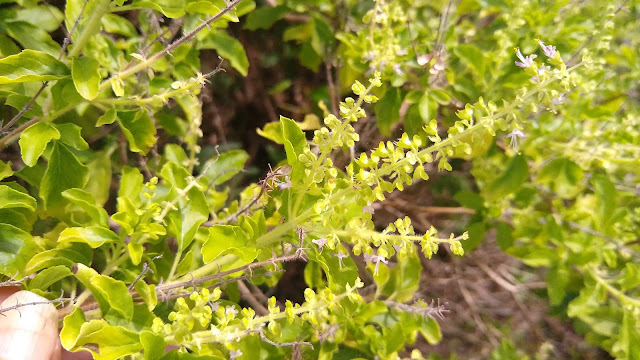Midterm in the field
The midterm in SC/SS 115 Ethnobotany was redeveloped and shifted to more closely mirror the authentic assessment used in the final examination. This also provides the students with a better idea of how the final examination will run, while also giving me some early insight into where problems may arise in that field final.
Class began with a setting of the essential ground rule of an honor system field evaluation of plants encountered during the first half of the term.
Volkameria inermis was first up.
Ocimum tenuiflorum was the second plant. While the students answered the questions I worked on trying the limited macro capabilities of my G7.
Scaevola taccada also known as Scaevola sericea was third. One white fruit was present on the plant.
I suppose I could try a three foot rule, but with 25 students that would spread the class over a much larger area. That does not seem practical and the intent is not to be draconian.
By and large students worked independently. And in some instances the glancing at other papers was to see if a friend had finished a question.
Piper ponapense
Phymatosorus scolopendria
Cycas spp.
Cymbopogon citratus
Araucaria columnaris
Centella asiatica
Seeking shade wherever available. The next two plants were Lycopodiella cernua and Dicranopteris linearis, which added a lycophyte to the midterm. I suggested that the northwest islanders from Chuuk should probably be familiar with some of the lagoon plant names such as unen katu. I have not required that, but noted that familiarity with plant names within one's state is potentially useful. Put another way, if I can learn unen katu and amare, then perhaps there is value in knowing these even i one is not lagoon Chuukese. The languages are connected and related, outer island Chuukese do use Chuukese when on Wene and communicate because of these connections. Just as I can learn what a redwood is and the name in English even though I have never seen one and grew up in the midwest. Unen katu is a Chuukese word for a plant that while not found in the northwest, is a word that functions in the Chuukese family of languages. That is, a northwesterner probably understands the meaning of the words unen katu (cat fur), thus learning the plant might not be an unreasonable expectation.
Carica papaya
Class began with a setting of the essential ground rule of an honor system field evaluation of plants encountered during the first half of the term.
Volkameria inermis was first up.
Ocimum tenuiflorum was the second plant. While the students answered the questions I worked on trying the limited macro capabilities of my G7.
Scaevola taccada also known as Scaevola sericea was third. One white fruit was present on the plant.
I suppose I could try a three foot rule, but with 25 students that would spread the class over a much larger area. That does not seem practical and the intent is not to be draconian.
By and large students worked independently. And in some instances the glancing at other papers was to see if a friend had finished a question.
Piper ponapense
Phymatosorus scolopendria
Cycas spp.
Cymbopogon citratus
Araucaria columnaris
Centella asiatica
Seeking shade wherever available. The next two plants were Lycopodiella cernua and Dicranopteris linearis, which added a lycophyte to the midterm. I suggested that the northwest islanders from Chuuk should probably be familiar with some of the lagoon plant names such as unen katu. I have not required that, but noted that familiarity with plant names within one's state is potentially useful. Put another way, if I can learn unen katu and amare, then perhaps there is value in knowing these even i one is not lagoon Chuukese. The languages are connected and related, outer island Chuukese do use Chuukese when on Wene and communicate because of these connections. Just as I can learn what a redwood is and the name in English even though I have never seen one and grew up in the midwest. Unen katu is a Chuukese word for a plant that while not found in the northwest, is a word that functions in the Chuukese family of languages. That is, a northwesterner probably understands the meaning of the words unen katu (cat fur), thus learning the plant might not be an unreasonable expectation.
Carica papaya






































Comments
Post a Comment